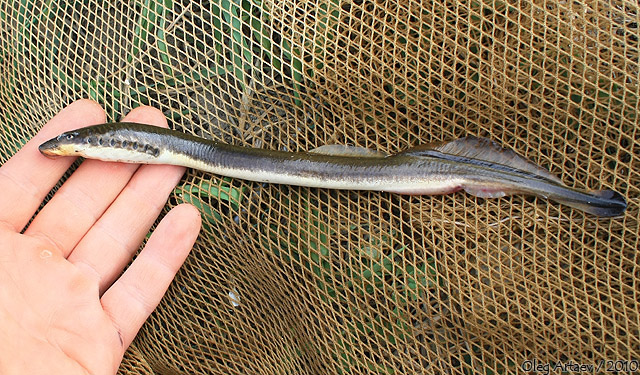| Europe: Drainages of the Baltic Sea (Odra, Vistula, Neman), northern Black Sea (Sava, Drava, Danube [except Tisza, Timis, and Cerna rivers], Prut, Dnieper, Dniester, Don, Kuban, and in rivers of Georgia from Bzyb' in south to Chorokhi in north), Aegean Sea (Vardar), and Caspian Sea (Volga - Sura River) (Ref. 58030). One record in the upper Morava system (Czechia) (Ref. 59043). |
|
Dorsal spines (total): 0-0; Dorsal soft rays (total): 0-0; Anal spines: 0-0; Anal soft rays: 0-0. Adults: 12.0-22.2 cm TL. Body wet weight of 37 individuals 13.1-19.5 cm TL, 3.61-12.69 g. Body proportions, as percentage of TL (based on 39 specimens measuring 12.3-19.5 cm TL): prebranchial length, 6.9-12.1; branchial length, 8.5-12.3; trunk length, 44.9-54.4; tail length, 24.3-31.3; cloacal slit length, 0.4-2.2; eye length, 0.7-2.1; disc length, 2.2-5.8; prenostril length, 2.5-6.5; snout length, 2.7-7.6; postocular length, 2.4-3.7. The urogenital papilla length, as a percentage of branchial length, in eight spawning males measuring 14.35-18.4 cm TL, 25.0-38.6. Trunk myomeres, 60-73. Dentition: Most labial teeth are villiform; supraoral lamina, usually only 2 unicuspid teeth, but in less than 10% of cases, 1-3 small unicuspid teeth may also be found on the bridge; infraoral lamina, 5-10 usually unicuspid teeth, but 1-2 lateralmost teeth may be bicuspid; usually 3 endolaterals on each side (83%), but 4 (11%), 1 (4%), and 2 (2%) also found; endolateral formula, typically 1-2-2 (26%), 1-2-1 (22%), 2-2-1 (13%), 2-2-2 (11%), but also 1-1-1, 2-2-3, 1-1-2-2 (each 6%), 2, 1-1-2-1 (each 4%), 1-2, 1-2-2-2 (each 2%) - Naseka et al. (2009) reported the following additional formulae from the syntypic series, including a count of 5 endolaterals: 1-1-2, 1-3-1, 2-1-1, 2-3-2, 1-2-2-1, 2-1-2-2, 1-1-2-1-1; 2-5 rows of anterials; first row of anterials, 5-10 unicuspid teeth, exceptionally, one lateralmost tooth may be bicuspid; 1-4 rows of exolaterals; rows of posterials, 0-3 (absent in 10% of individuals only); first row of posterials, either complete (continuous) with 12-20 unicuspid teeth (62% of individuals) or incomplete (discontinuous) with 1-12 unicuspid teeth (38% of individuals) or entirely absent (very rarely) - Naseka et al. (2009) reported the following additional counts from the syntypic series: complete row with 10 unicuspid and 1 bicuspid teeth; incomplete row with 13-17 unicuspid teeth and with 4 unicuspid and one bicuspid teeth; transverse lingual lamina, 3-7 unicuspid teeth, the median one enlarged (in 79% of individuals, the median cusp is both higher and wider, while in 21% of individuals it is wider, but not noticeably higher, than the flanking cusps); longitudinal lingual laminae each with 5-11 unicuspid teeth. Velar tentacles, 7-12, with tubercles. No dark blotch near the apex of the second dorsal fin. Lateral line neuromasts unpigmented or darkly pigmented, at least on the ventral aspect. Extent of caudal fin pigmentation (- = absence to trace; + = 1% to under 25%; ++ = 25% to under 75%; +++ = 75% or more): - (7%), + (3%), ++ (13%), +++ (77%). Caudal fin shape, spade-like (97% of individuals), rarely rounded. Oral fimbriae, 88-98 (Ref. 89241). With 62-73 trunk myomeres. The caudal fin is dark grey to black (Ref. 59043). |
| Adults are found in freshwater; in brooks, rivers, and lakes (Ref. 89241). They inhabit the mountain and foothill zones of watercourses containing clear water with a strong current and gravel-sand substrate. The ammocoetes larvae live in detritus-rich sand-mud substrates in areas of weak current, frequently beneath overhanging banks. Ammocoetes feed on diatoms and detritus; adults don't feed. Metamorphosis occurs in September in Poland and Slovakia and in July in the Ukraine. Ammocoetes used as live bait (Ref. 12283). Adults are preyed upon by Esox lucius (Ref. 89241), the chub (Leuciscus cephalus) and other predators in the period of their spawning (beginning of May to beginning of June). Mature individuals form spawning aggregations (Ref. 59043). Spawning occurs on gravel and sand substrates, also possibly over hard white clay (Ref. 58030), in late April - early May in the Ukraine. Fecundity, 1,950-7,106 eggs/female (Ref. 89241). Adults are nonparasitic. However, rare cases of ectoparasitism have been reported in Jelesná Brook, Slovakia and the Prut River, Ukraine (Ref. 89241). |
